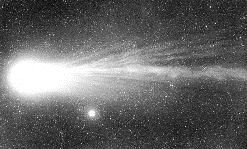

Hyakutake, unlike Comet Hale-Bopp, was formed in interstellar space. Sky and Telescope (Feb 98) Newsnotes reports that, according to ultraviolet and millimeter-wave observations, Hyakutake has isotope ratios consistent with an interstellar origin. Hyakutake passed within about 15 million km of Earth. Although many comets have approached closer (in 1491 AD a comet came within about 1.4 million km) Hyakutake was the brightest comet to come so close to Earth in the past 440 years or so, according to Fred Schaaf. The image above was taken on 20 March 1996 by Shigemi Numazawa. The north polar composite image immediately below was taken 26-27 March 1996 by Phil Hudaon.
According to Richard West of ESO Brian Marsden, from 371 positions (January 1 - March 18, 1996) finds an original period of about 8,600 years since its current entry into the inner solar system and a future period of about 17,000 years due to perturbations by planets during the present passage, and Don Yeomans has found the current period to be about 18,400 years. Very roughly rounding, I take 10,000 years to be the original period and 20,000 years to be the current future period.
_______
_Starfire
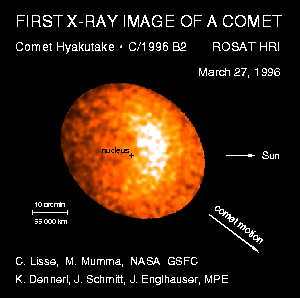
Hoyle and Wickramasinghe (see New Scientist 11 May 96) propose that the X-rays are solar X-rays scattered by grains of carbon-based material a few nanometers in diameter. That is consistent with their theory that comets shed large amounts of viruses, and so seed planets with life. Secker, Wesson, and Lepock have shown that viruses and bacteria could be ejected from a red giant star system by radiation pressure, and that they could survive interstellar travel if shielded against ultraviolet radiation by a thin carbon layer. Even if they were not shielded, enough fragments of DNA, RNA, and protein would be transported to seed a planet for rapid evolution of life, even if the planet had a carbon dioxide atmosphere rather than a reducing atmosphere. Ethane and methane have been observed by the 3-meter NASA Infrared Telescope Facility at Mauna Kea according to a paper in Science 272 (31 May 1996) 1263-4, 1310-4. The ethane levels are "about 1,000 times greater than can be explained if the molecules were formed by normal physical processes within the gases of the primordial solar nebula".
On 26 March 1996, Hyakutake was about 0.107 AU from Earth, and two condensations were observed behind the nucleus, one about 1250 km behind (antisunward) the nucleus, and another dimmer one about 3500 km behind the nucleus.
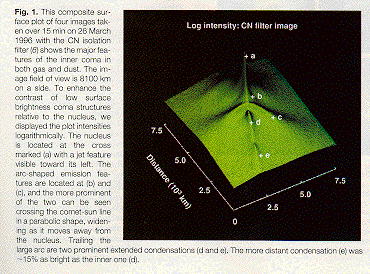
(Harris, Combi, Honeycutt, Mueller, and Scherb, in Science, 277 (1 August 1997) 676-681))
GAMMA RAY BURST observed very near Hyakutake on 9 April 1996:
On April 11, 1996, Hyakutake was very near where Hale-Bopp would be a year later. Bill Hutchinson of Kenai, Alaska, photographed both comets on 11 April 1996 and 1997:
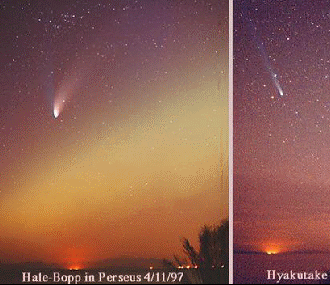
Hyakutake reached perihelion on 1 May 1996, at which time the Sun had a coronal mass ejection (CME)
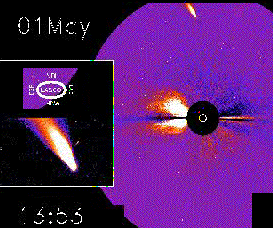
seen by LASCO as "... an explosive solar event in which matter streams out from the sun at hundreds of kilometers per second ... ".
FRAGMENTATION of Hyakutake _Pic du Midi
According to Geraint H. Jones, Andrea Balogh, and Timothy S. Horbury ( Nature 404 (6 April 2000) 574-576 ), "... Here we report
This surpasses the tail length of 2 AU determined for the Great March Comet of 1843 (C/1843 D1). Our measurements reveal that, at this distance, the tail of comet Hyakutake was a structured entity at least 7 million kilometres in diameter. ...
... The Ulysses spacecraft (the first to explore the out-of-ecliptic solar wind) recorded anomalously low solar-wind proton number densities for several hours on 1 May 1996. An unusual magnetic field structure was detected simultaneously by the spacecraft's magnetometer. ... Our search for the source comet led to analysis of the relative locations of Ulysses and the then-productive comet Hyakutake. On the day of the proton number-density drop, Ulysses was radially aligned with the position that Hyakutake had occupied approximately 8 days earlier. This time difference was in the range of travel times expected for cometary plasma to traverse the space between the comet and spacecraft. The highly unusual alignment of the two objects coinciding with the 1 May event is strong evidence that Ulysses crossed Hyakutake's plasma tail ...
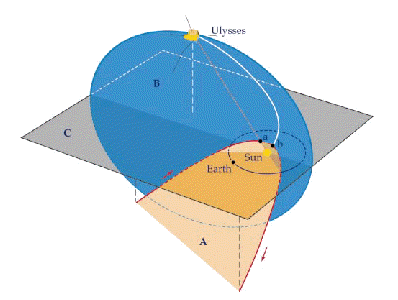
... The presence of a coherent structure so far from the nucleus suggests that the plasma tails of comets may persist as discrete entities for many astronomical units. As the tail of Hyakutake persisted to Ulysses, it is likely that this structure, ultimately produced by an object only [about] 2.4 km across, survived to reach the edge of the heliosphere. ...".
......